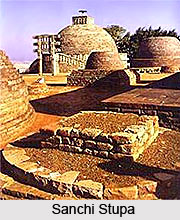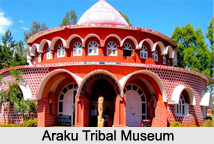 Like most other museums in India, the Sanchi Archeological Museum also owes its origin to an English General accidentally uncertain upon some ancient ruins around 1818. Ultimate archaeological explorations discovered one of the richest sculptural findings of Buddhist tradition. Emperor Ashoka started the original stupa here. Following Ashoka`s foot steps other generations continued to modernize and decorate the original brick stupa with delicately sculpted stone. This period of splendid creativity extended between 3rd century BC and 13th century AD, blending Hindu and Buddhist styles and building a complex of stupas, temples, monasteries, etc that remain supreme in excellence of form and beauty of detail. There is a lion capital of an Ashoka pillar here very similar to the one found at Sarnath, the latter now the emblem of India. Other notable sculptures found here include statues of the Buddha, several bodhisattvas and early Hindu period statues of Ganesh, Mahishasuramardini among others.
Like most other museums in India, the Sanchi Archeological Museum also owes its origin to an English General accidentally uncertain upon some ancient ruins around 1818. Ultimate archaeological explorations discovered one of the richest sculptural findings of Buddhist tradition. Emperor Ashoka started the original stupa here. Following Ashoka`s foot steps other generations continued to modernize and decorate the original brick stupa with delicately sculpted stone. This period of splendid creativity extended between 3rd century BC and 13th century AD, blending Hindu and Buddhist styles and building a complex of stupas, temples, monasteries, etc that remain supreme in excellence of form and beauty of detail. There is a lion capital of an Ashoka pillar here very similar to the one found at Sarnath, the latter now the emblem of India. Other notable sculptures found here include statues of the Buddha, several bodhisattvas and early Hindu period statues of Ganesh, Mahishasuramardini among others.
With the view of covering the object discovered in the track of excavations at Sanchi, a small museum was established on the top of hill, in 1919, by Sir John Marshall, former Director General of ASI. Later on, due to lack of space as well as for aesthetically displaying the museum objects, Archaeological Survey of India acquired a college building at the base of the hill of Sanchi Stupa and got the exhibits shifted to the new building in the year 1966. The museum comprises of a Main hall and four galleries. Majority of the objects are from Sanchi itself and a few from Gulgaon, Vidisha, Murelkhurd and Gyaraspur. The Archeological Museum is a must see.  Metal-tools and beautiful sculptures as old as 2000 years makes the viewer think about that era. The museum also showcases the history and revival of this place.
Metal-tools and beautiful sculptures as old as 2000 years makes the viewer think about that era. The museum also showcases the history and revival of this place.
At present there are four galleries named as Gallery No. 1 to 4, besides a verandah having nine exhibits. There are 16 outstanding objects ranging in date from 3rd century B.C. to medieval period on demonstration collected from the remains of Sanchi itself and few from the neighbouring area. The Ashokan lion Capital with four lion seated back to back exhibited in a niche in the main hall invites visitor`s attention. This lion capital, of Ashokan pillar bearing typical Mauryan shine is the most outstanding display and exceptionally attracts ones attention. The objects aesthetically displayed in the gallery are the representative member of six cultural periods i.e. Maurya, Sunga, Satvahana, Kushana, Gupta and post Gupta period. The colossal image of Nagaraja displayed against the northern wall is a classical representation of Sunga period. A Torana member depicting Buddha`s enlightenment under a Pipal tree is unique for its Hinayana art. The other noteworthy exhibits are Yakshi (1st Cent. B.C.), Dhyani Buddha of Mathura in spotted red sandstone (4th cent.A.D.) and Bodhisattva Padmapani (5thCent. A.D.)
Archaeological Library
The Central Archaeological Library was established in the year 1902. It is housed in the second floor of the National Archives Annexe, Janpath and New Delhi. The collection of books at the library is around 1,00,000, which, consists of books and journals. These library houses books and periodicals on various subjects namely History, Archaeology, Anthropology, Architecture, Art, Epigraphy & Numismatics, Indology, Literature, Geology, etc.  The library also houses many rare books, plates, original drawings, etc. The books are classified according to the Dewelly Decimal System. The ASI maintains library in each Circle and branch to cater to its academic and technical requirements leading to research of primary nature.
The library also houses many rare books, plates, original drawings, etc. The books are classified according to the Dewelly Decimal System. The ASI maintains library in each Circle and branch to cater to its academic and technical requirements leading to research of primary nature.
The Archaeological Survey of India brings out a variety of publications since its inception, both annual and special with subject matters ranging from archaeological researches in excavations, explorations, conservation, architectural survey of temples and secular buildings besides epigraphy and numismatics. In addition to these, the survey brings out popular literature in the form of guidebooks, folder/brochures, portfolio and picture post-cards on centrally protected monuments and archaeological sites. During the 50th year of Independence of India, the Archaeological Survey of India has also initiated to prepare and publish an `Inventory of Monuments and Sites of National Importance` containing details of centrally protected monuments and sites under various Circles along with their plans and photographs so that it could cater to the needs of the heritage administrators, scholars and tourists.


















